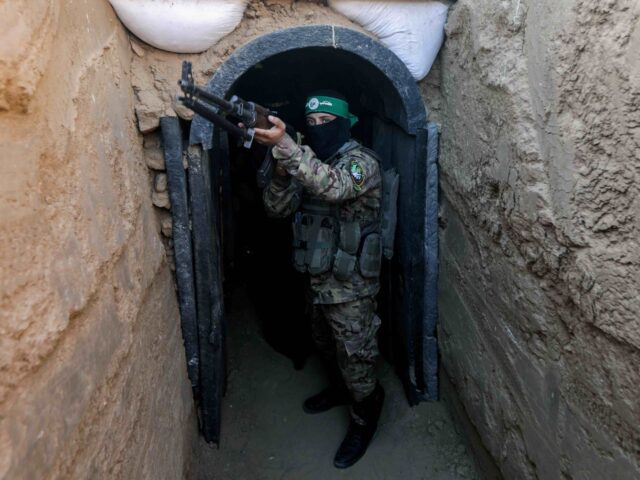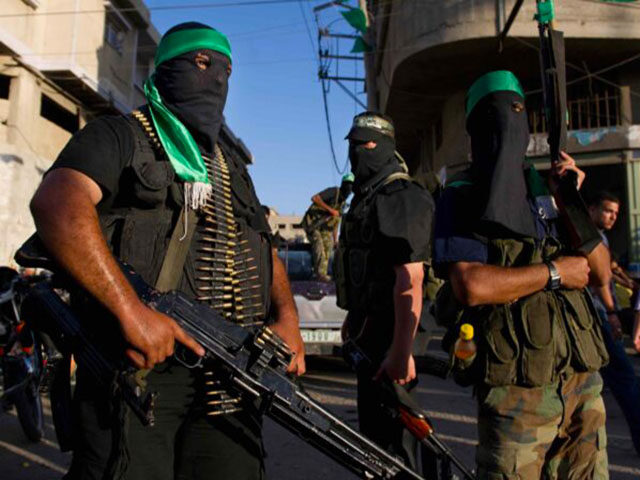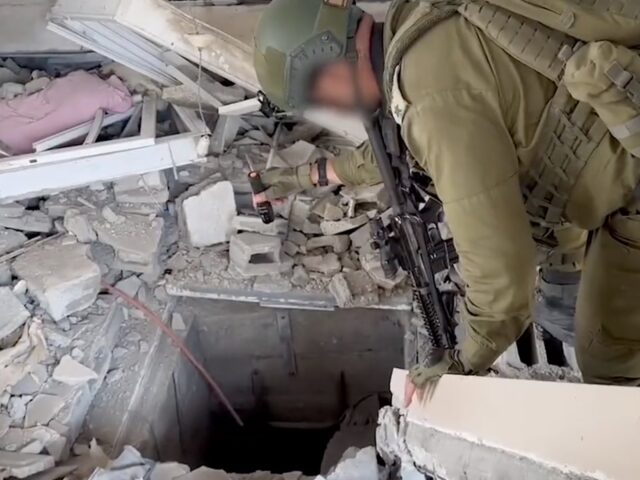Despite the “nightmare” of tunnel warfare, the mission being carried out by the Israel Defense Forces (IDF) appears “very successful,” though Israel doesn’t have unlimited time, according to retired United States Army Major and urban warfare expert John Spencer, who deemed Hamas an “existential threat” whose strategy is to “create their own civilians’ deaths and get the world to react,” in order to prevent the IDF from eliminating their military capabilities — “and it is working.”
He also accused those protesting Israel’s supposedly “disproportionate” response to Hamas of having “no understanding of war, the laws of war or how the world works,” and that the terror group would “slaughter” the protesters, if given the opportunity, “for not being radical Islamic followers.”
In an exclusive interview with Breitbart News, retired U.S. Army Major John Spencer, a world-renowned expert on urban combat who serves as chair of urban warfare studies at the Modern War Institute (MWI) at West Point, delved into the various warfare tactics at hand during the current Middle East conflict.
IDF’S STRATEGY
Spencer, a founding member the International Working Group on Subterranean Warfare, deemed the IDF’s activity against a plainclothes enemy embedded amongst civilians “very precise.”
“Of course, very costly,” he said. “But it’s not unlike any other urban battle I’ve seen.”
While Gaza is a “very highly dense place,” he noted, “cities like Baghdad, Mosul, and Raqqa are more dense,” though that “doesn’t mean it’s not any harder to operate in it.”
“From the ground perspective, as somebody who teaches this to armies around the world, I think they have been very deliberate in their approach to go through the steps that would be required to accomplish the mission they have stated, whereas a lot of militaries aren’t as clear in their objectives,” he said.
Citing a Vietnam-war saying, “you have to destroy the city to save it,” Spencer said the fact is unfortunate, “but it’s the reality of urban fighting.”
The saying conveys that there is a defender inside the city, which, in order to clear out “you basically destroy the city.”
“And there’s nothing I’m seeing now that changes that paradigm,” he added.
Deeming the IDF’s battle against Hamas “enemy–centric,” in that the mission to destroy Hamas’ military capabilities is “very clear,” the retired Army officer explained that the task cannot be done [entirely] from the air, though an air campaign can be used “to attrit rocket sites, command-and-control centers, the ability to communicate, and the ability to move — even underground.”
“As far as I can tell,” he assessed, the mission being carried out by the IDF appears “very successful.”
“Now they’ve moved forward methodically surrounding the city; the step that we call ‘isolate’ the city,” he explained, with reports indicating that the northern part of Gaza is now completely cut off.
“And I’m sure that means both on the surface and underground, because isolating the surface doesn’t mean you’ve isolated the underground,” he added.
But Israel’s current conflict with the terrorist Hamas group is actually the Jewish state’s fight against an “existential threat” that’s been “allowed through U.S. encouragement” to fester, and October 7 was a result of that.
“Hamas has in their charter the complete destruction of Israel and the slaughter of the Jewish people, and it tried that on October 7 on as many as they could,” he added.
UNDERGROUND WARFARE
Despite the difficulty in fighting Hamas, Israel is not facing “mission impossible,” Spencer asserted.
Having “traveled the world, and been in tunnels all around the world,” as well as having “studied the way militaries approach, or don’t approach, underground warfare,” he concluded that the IDF are “leaders of the world in developing technologies, tactics and trained personnel for this specific mission.”
“They have one of the biggest underground units, the Yahalom, which is a special forces engineering unit.”
They also have modern day “tunnel rats,” dog units, and a “complete major organization that does experimentation and research to develop things,” he noted.
Spencer highlighted the challenge of underground warfare, where “nothing that any military developed for the surface of the Earth for fighting works.”
You can’t see down underground without special night vision because there’s no ambient light, which is what most of most night vision goggles use. You can’t navigate down there because there’s no satellite transmission. You can’t communicate because there’s no satellite or line of sight radio frequency down there that will work. Many places down there you can’t breathe. Many of your munitions can’t fire down there because the concussion will blow your eardrums and give you basically a concussion, without special equipment.
In addition, he explained, such depths can’t be reached with aerial technologies.
“Hamas dug deeper and deeper because of the fact that bunker buster bombs can go about 100 feet underground,” he said, “and the IDF has already found some Hamas tunnels 200 feet underground, below where any bunker buster can get to [or] any munition.”
The Israeli military believes, he noted, that there are likely tunnels even “300 feet” beneath the surface.
While the IDF “has some of the greatest equipment and little robots they can send down, drones that bounce off walls, remote control cars, and dogs,” with 300 miles of such tunnels, “you’ll quickly run out of that capability.”
“And sending somebody into a tunnel is the last resort, so you always seek a way not to go into a tunnel,” he explained.
However, he noted, the IDF has some personnel that can, including “everything from special forces throughout Sayeret Matkal, to the special soldiers that have been trained for it.”
Another issue is the presence of captives in such tunnels.
“We’re 99 percent sure all hostages, or a majority of them, are underground. So even some of the historical methods in which militaries used to deal with tunnels — whether it’s to explode them or neutralize them by putting tear gas in them or flooding them or something similar, you won’t initially be able to do because you have to map and navigate the tunnel to see if there are hostages down there,” he said.

GAZA, PALESTINE – 07/19/2023: A fighter from Izz al-Din al-Qassam stands in front of a tunnel during an exhibition of weapons, missiles and heavy equipment for the military wing of Hamas in the Maghazi camp in the central Gaza Strip, during the commemoration of the 2014 war that lasted 51 days between Gaza and Israel. (Yousef Masoud/SOPA Images/LightRocket via Getty Images)
Calling such a scenario a “really wicked problem” and a “nightmare to fight in,” Spencer explained why previously common methods are not feasible under current conditions:
Even the basic military, what we teach every soldier in every military in the world, is to fire and move. In a tunnel there’s no fire and move. There’s just fire down the tunnel and maybe fire back at you. You can’t flank them. You can’t move around them. You can’t surprise them. So it’s really a nightmare of a place to have to go fight or have to even enter. You can’t even breathe down there without special breathing equipment, depending on the depth that it goes and the ventilation that it has.
However, he insisted, the presence of hostages underground is not an impossible problem to solve, rather it merely means that forces must move slower and the mission will take more time.
“Israel developed the world’s first hostage rescue teams that the rest of us have now copied. So they have hostage rescue teams and many special forces units that all have underground training,” he said. “They can put a drone into a tunnel beforehand to see if there’s a hostage down there before they do something to it.”
He expressed his belief that for the IDF to accomplish its objectives, it would need several months, “based on other examples.”
“Although the hostages make this situation very unique — there’s no historical precedent for that at this scale — I would say it will take months.”
“I don’t think years, just months,” he said, “but definitely not days, and unlikely weeks.”
However, he maintained, the real question is how much time they have, and not how much time it will take.
“No military gets unlimited time, and Israel doesn’t have unlimited time,” he said. “So that means you’re going to have to make a lot of decisions about risk, and take risks and make hard military decisions.”
CIVILIAN CASUALTIES
With many concerned for civilian casualties, Spencer insisted that “all the laws of war that were created — really, strengthened — after World War Two, have gotten a lot stronger.”
“No more carpet bombing of cities like the U.S. and every other country involved in WWII were trying… whether it’s the London Blitz or Dresden or what the U.S. did to Tokyo,” he stated. “The idea that you can bomb your enemy to your goals has really happened very few times in the history of wars and worked.”
In addition, he stated, such a strategy “definitely wouldn’t accomplish the Israeli mission of destroying military infrastructure and capability.”
“You have to use joint power: air, land, sea, and cyber,” he explained, “but you have to get in there and clear, destroy tunnels, destroy Hamas members, and destroy Hamas rockets.”
“So from a military analyst perspective I think they’re doing pretty good,” he added.
Regarding civilian casualty numbers, Spencer noted that they are “not unlike other battles” in recent history.
“In the Battle of Mosul, there were 10,000 civilian casualties in a city of 1.4 million civilians where ISIS kept the civilians there for a long time before they could start to evacuate,” he said. “But by sheer numbers, they evacuated 80 percent of the urban areas. And while that’s still hundreds of thousands of people, militaries are never able to empty all of the cities, it just never happened.”
“Even in WWII in the Battle of Aachen, where we cleared the city four times, there were still hundreds of civilians in the city and lots of civilian casualties,” he added.
He also pointed to when U.S. forces “surrounded Fallujah, and spent six months — that Israel doesn’t have — to empty 90 percent of the civilians there,” yet there were still many casualties.
“So there are a lot of similarities,” he noted.
According to Spencer, when an enemy chooses to defend from urban terrain and use human shields, the results we see are “not abnormal.”
“Really, the civilian casualties are 90 percent of the casualties of modern war, not military,” he explained, “because modern war fights are happening in cities, not fights for cities, which is really ancient, fighting for cities.”
Today, in contrast, militaries fight in cities for a variety of reasons, he noted. For example, Hamas militants “can gain a large amount of power [by fighting] in urban environments.”
“They take away the attacker’s military superiority, just to bring the fighting close and have a slugfest,” he said. “So that means more and more warfare.”
“But out of the last 20 years, 90 percent of the casualties of war have been civilians,” he added.
Spencer also explained that “everybody” misunderstands the notion of proportionality.
“We should not be comparing the amount of Palestinian civilian deaths to the amount of Israeli civilians killed on October 7 — 1,400 versus supposedly 10,000 (I’m highly doubtful that’s an accurate number, but it doesn’t matter),” he said. “That’s not the way war works. That’s not even close to the definition of proportionality — it has nothing to do with it.”
“Every civilian death is, of course, a loss, but people that want the end of the conflict because of the fact that it’s not ‘proportional’ to what happened on October 7, have no understanding of war, the laws of war or how the world works,” he added.
Reflecting on his having taught strategy at West Point for years, Spencer determined that Hamas’ strategy is to “create their own civilians’ deaths and get the world to react,” in order to prevent the IDF from eliminating their military capabilities, — “and it is working.”
“Despite the fact that I can tell every news agency in the world that what we’re seeing in Gaza is not unlike what we’ve seen in battles against ISIS in Mosul, Raqqa, Syria, and Marawi — nobody cares,” he said. “They’re still saying, ‘no, no, stop.’”
“That’s the Hamas strategy, to get so many civilians killed that the IDF will have to stop, and Hamas gets to live to fight another day,” he added.
Another Hamas strategy he indicated is that of buying time.
“Most defenders in history lose, but one of the goals can be just to buy time,” he said. “So Hamas is going to use guerrilla warfare, use complex urban terrain and snipers, ambushes, IEDs, and pop out of tunnels, just to slow the IDF down, so that they can’t achieve their goal quickly.”
“The IDF needs time — and Hamas’ strategy is to take that time away from them, by putting all these pressures, getting every Palestinian, every Muslim of the world, to force international leadership to try to encourage the IDF to stop,” he added.
In light of the above, Israel should “absolutely” be given the time and space to achieve its goals.
To even destroy the tunnels, you’ve gotta clear the tunnel. You’ve gotta make sure there’s no military equipment, hostages, or fighters, in them. Then they have to destroy the tunnels, and that would be historic because even some of the ways militaries have destroyed tunnels aren’t an option to fully destroy 300 miles of tunnels. One of the only options is to flood them with seawater — which would necessitate time.
And while the IDF needs to be given the time, he acknowledged, it is crucial to “not allow Hamas’ strategy of buying time to succeed.”
DEMONSTRATIONS
On protesters who have come out in large numbers against Israel’s response, Spencer suggested “they have no clue of what war looks like,” despite possibly being well-intentioned.
“War happens in cities, and though it may appear like the IDF is indiscriminately bombing the cities of Gaza, that’s not the case and I have seen nothing that shows that,” he said. “In fact, this looks very similar to most U.S.-backed operations.”
“It’s what happens when an enemy embeds itself in a civilian population and the civilians are in an urban area,” he added. “Every strike is a targeted military target, but this is what war looks like.”
Addressing the “double standards” of those who protest Israel’s fight against Hamas while ignoring significantly controversial events such as the recent move by Pakistan to expel 1.7 million Afghan refugees, Spencer explained that the IDF, for various reasons, is “held to a standard above and beyond any other standard that we hold any other military in the world.”
“It’s scrutinized and held to a standard that isn’t actually within the laws of war,” he said. “It fights in that limelight, at a standard that nobody else is held to.”
However, he noted, Hamas would “slaughter” those protesters “for not being radical Islamic followers.”
“They would slaughter them — do horrific things — just like they slaughtered the people on October 7.,” he added.
Joshua Klein is a reporter for Breitbart News. Email him at jklein@breitbart.com. Follow him on Twitter @JoshuaKlein.


COMMENTS
Please let us know if you're having issues with commenting.